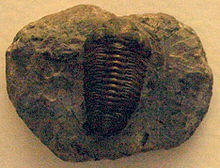| Acaste | |
|---|---|
 | |
| Acaste downingiae, on display at the Natural History Museum, London | |
| Scientific classification | |
| Kingdom: | |
| Phylum: | |
| Class: | |
| Superorder: | |
| Order: | |
| Superfamily: | |
| Family: | |
| Genus: | Acaste Goldfuss, 1843 |
| Species | |
| |
| Synonyms | |
| Acastina | |
Acaste is a genus of extinct trilobite of the order Phacopida which lived throughout the Silurian period.[1] They are characterized by a convex dorsal surface, an absence of spines, a shortening of the head-shield and a general rounding off of all angles.[2] Species include Acaste downingiae [3] (Wenlock Series).
Etymology
- A. lokii is named after Loki, the Norse god of mischief. Loki tricked the blind god Höðr to kill the god of beauty Baldr, and so started the demise of the world (or Ragnarök). This epithet was chosen by Edgecombe because it is based on the cephalon of A. longisulcata, which has turned out to be a mixed collection. The pygidium of A. longisulcata belongs to a Phacopoidea.[1]
- A. zerinae is named in honor of Zerina Edgecombe, the wife of the species author.[1]
Taxonomy
Species previously assigned to Acaste
Some species originally designated to Acaste have now been reassigned to other genera.[4]
- A. birminghamensis = Llandovacaste birminghamensis[1]
- A. constrictus = Acastoides constricta
- A. cordobesa = Pennaia verneuili[1]
- A. henni = Acastoides henni
- A. verneuili = Calmonia terrarocenai[1]
See also
References
- ^ a b c d e f Edgecombe, G.D. (1993). "Silurian Acastacean trilobites of the Americas" (PDF). Journal of Paleontology. 67 (4): 535–548.
- ^ H H Swinnerton - Outlines of Palaentology, Edward Arnold (Publishers) Ltd, 1972 (p. 247) ISBN 0-7131-2357-5.
- ^ British Palaeozoic Fossils - Natural History Museum 4th edition 1975. Plate 29. ISBN 0-565-05624-7.
- ^ Moore, R.C. (1959). Arthropoda I - Arthropoda General Features, Proarthropoda, Euarthropoda General Features, Trilobitomorpha. Treatise on Invertebrate Paleontology. Part O. Boulder, Colorado/Lawrence, Kansas: Geological Society of America/University of Kansas Press. pp. 1–560. ISBN 0-8137-3015-5.